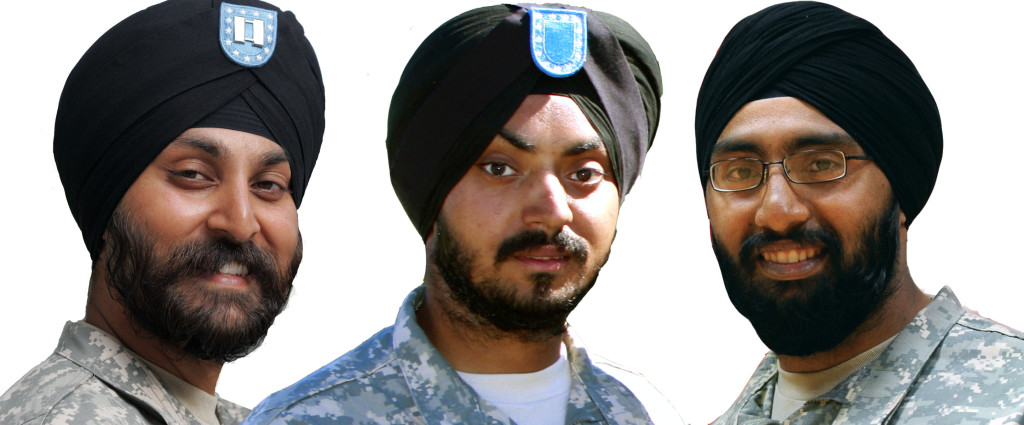Religious Accommodation Expands Beyond Christianity

Courtesy of the Sikh Coalition
The Department of Defense has published an updated regulation on religious accommodation (see text: DoDI 1300.17). They represent a thorough and thoughtful effort to manage post-DOMA strife caused by some who continue to oppose all lesbian and gay rights. It is only fair to point out that military policy and culture was, up until recently, effectively anti-gay. Many anti-gay persons became comfortable in the military with statements, practices, and isolation that fit their anti-gay ideology. Now, as the military changes, it is reasonable to steward everyone, from the cheering LGBT allies to the jeering anti-gay fundamentalists, through the changes. But the new regulations are not all about the LGBT culture clash. Sikh Americans and nontheists were given significant concessions in the new regulations as well.
David Niose, Legal Director of the American Humanist Association, “The revised regulations on religious accommodation are encouraging, but humanists and other nontheists are still waiting to see real-world change in the military. Actions, not words, are what we seek. Humanist chaplains would be a sensible first step, a concrete and meaningful move that would demonstrate the chain of command’s understanding of the value of our large and growing segment of the military demographic.”
These new regulations follow the annual conference of the National Conference on Ministry to the Armed Forces (NCMAF) held each year in January. Chaplains are closely consulted and advised on these issues despite the potential conflict of interest that my arise from a 98% Christian chaplaincy. These conflicts of interest seemed to display themselves in a negative fashion when, in 2011, barriers to diversity were raised by the Armed Forces Chaplains Board following the appointment of the first Hindu Chaplain. The new regulation, on the whole, shows a positive step forward for diversity.
The obvious beneficiaries are Sikh Americans whose beliefs forbid its members from cutting their hair. This practice had in the past contradicted military policy. However, several individual exemptions have previous been provided, including a Sikh member in 2009 and a Jewish member in 2011. These individual exemptions, after several years of testing, have now been authorized as general policy. It is also the case that foreign militaries and military personnel with medical conditions have been allowed to grow beards, or at least not shave regularly. Accommodation requests must be renewed individually at each command level, and so Sikh Americans may find themselves unable to adhere to their beliefs when they move into a new command. They say this there must be a blanked approval before they are fully accommodated.
There has been significant opposition to Sikh hair and headgear accommodation from parts of the nontheist community. Many nontheists initially consider the accommodations to be unnecessary and unfair. Many have a firm church-state stance that does not include any accommodations for religious belief. However, many nontheists including MAAF praise the accommodations as a healthy diversity initiative that will have minimal negative impact and a strong positive impact on team cohesion.
The new policy was discussed in a House Armed Services – Military Personnel subcommittee hearing on January 29th that I attended. The panel assembled for questions included chaplaincy leaders from the DoD and each branch of service. The event was attended by Miss Davis, California, advocating for diversity and inclusion, and a group of Congressional Prayer Caucus members who seemed primarily concerned that all chaplains would have unfettered opportunity for Christian proselytism and sectarian prayer. The chaplain leaders stated that they weren’t aware of any restrictions on prayer nor any instances of discrimination by those subject to proselytism or those trying to exercise their faith. These were all very explicit assertions, at least from my perspective in the audience, but I can only assume that was some sort of political equivocation as those leaders and the audience could all list many instances of restrictions and complaints related to religious speech and action.
Returning the the contents of the regulation: From the nontheist perspective, it is an evolutionary leap forward that the regulation states, “the Military Departments will accommodate individual expressions of sincerely held beliefs (conscience, moral principles, or religious beliefs) of Service members in accordance with the policies and procedures in this instruction.” While this does not explicitly reference atheists, humanists, or other nontheists, by referencing sincerely held beliefs, conscience, and moral principles alongside religious beliefs, it would be hard to restrict this “religious” accommodation exclusively to traditional divine religious beliefs. This wording emphasizes existing Constitutional legal precedent (such as Welsh v. United States, 398 U.S. 333 (1970); United States v. Seeger, 380 U.S. 163 (1965)).
The DoD has clearly spent significant time and effort in managing the objections of anti-LGBT Christians. The language of religious accommodation from the DoD is strong, and just as strong is the commitment to good order and discipline and unit cohesion.
Because the military is a specialized community within the United States, governed by a discipline separate from that of the rest of society, the importance of uniformity and adhering to standards, of putting unit before self, is more significant and needs to be carefully evaluated when considering each request for accommodation of religious practices. It is particularly important to consider the effect on unit cohesion. The excerpt below shows what is, at least to start, a thoughtful and workable policy in this post-DOMA transition period. All requests for accommodation of religious practices will be assessed on a case-by-case basis. Each request must be considered based on its unique facts; the nature of the requested religious accommodation; the effect of approval or denial on the Service member’s exercise of religion; and the effect of approval or denial on mission accomplishment, including unit cohesion.
These regulations are a step forward for diversity for all personnel of all beliefs, but there is a lot of work to do, and hopefully everyone of all beliefs will be afforded a seat at the table.
Additional Notes
The treatment of terms was concerning. The term “Substantially Burden” is defined as, “significantly … as opposed to minimally interfering with the exercise of religion.” And “Exercise of Religion” is defined as “any religious practice(s), whether or not compelled by or central to, a system or religious belief.” “Substantially” is defined as the “significantly” and “Exercise of Religion” is any practice labeled “religious” whether or not it is compulsory or central to a belief. There is no definition of religion, proselytizing, or evangelism within this regulation or referred to in this regulation, but there should be. Those oversights leave unresolved the continuing exclusion of nontheistic and naturalistic beliefs like humanism from chaplaincy training and services.
The Instruction states that personnel may “observe the tenets of their respective religions” and now add a reference to “observe no religion at all.” The DoD should be commended for adding this but there is still the question of nontheistic and naturalistic beliefs. Humanists and other nontheists should should also be included and supported equally within the military team, not marginalized as “no religion at all.” The inclusion of conscience language elsewhere in the regulations is a positive step, but only explicit reference to nontheistic and naturalistic beliefs can really make this clear to what has historically been a theistic chaplaincy.
